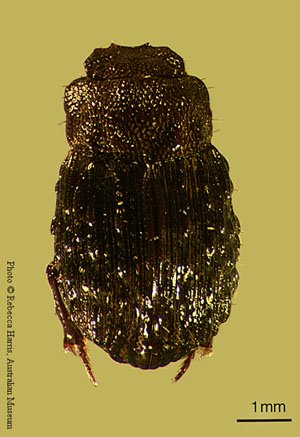![]()
![]()
![]()
Genus Demarziella
 Species found in eastern NSW: D. interrupta, D. metallica, D. scarpensis, D. sylvestris.
Species found in eastern NSW: D. interrupta, D. metallica, D. scarpensis, D. sylvestris.
Other species: D. alternata, D. mirifica (Qld, NT); D. planitarsis (NT)
D. tropicalis, D. pratensis, D. geminata, D. imitatrix, D. yorkensis, D. eungella, D. storeyi (Qld)
Distribution
Northern New South Wales to tropical, northern Australia.
Description
Small to medium sized (length 2.9-5.0mm), oblong, feebly convex. Dark brown in colour, often bronzed, one species metallic. Antennal clubs yellow. Dorsal surface with sparse stout bristles and some very short setae.
Two small clypeal teeth; frontoclypeal area elevated into a low transverse ridge or short horn in male. Anterior part of underside of pronotum deeply excavated, bounded posteriorly by a complete keel running to lateral edges, a second keel parallel to lateral edges posteriorly.
Elytra: elytra with 10 striae, including one along epipleural edge. 8th stria only represented by a short anterior section; 9th stria only posterior half present, very close to 10th stria; 10th stria greatly enlarged and deepened anteriorly. Epipleura of moderate width, their upper edges keeled. No pseudepipleura. Some stout bristles on elytra.
Hind wings: Fully developed.
Legs: Outer edge of fore tibiae with 3 teeth. Middle coxae oblique. Middle and hind tibiae strongly expanded distally, without any transverse keels. Two short unequal spurs on middle tibiae and one short spur on hind tibiae. Claws small, simple. All leg segments with short bristles.
Abdomen: All sternites fused, the last considerably longer along midline in both sexes. Pygidium with setae, fully margined, with a groove along dorsal edge.
Sexual dimorphism
Male fore tibiae more slender, with the inner apical angle prolonged into a false spur, the true spur smaller than in female and directed outwards.
Similar Genera
Amphistomus, of similar size, with tuberculate elytra.
Obvious differences: Amphistomus with 6 clypeal teeth, without stout bristles on dorsal surfaces.
NOTE: Demarziella species superficially resemble species belonging to a different subfamily, the Aphodiinae. Check that all the characters listed in the "How to tell if your beetle is a dung beetle" page are present.
Ecology
Adults coprophagous, winged, in tall open forest, open forest, closed forest and open areas.
References
Cassis, G. & Weir, T.A. (1992) Scarabaeinae. pp 106-173. In: Houston, W.W.K. (ed.) Zoological Catalogue of Australia. Coleoptera: Scarabaeoidea. Canberra: AGPS Vol. 9.
Matthews, E.G. (1976) A revision of the Scarabaeine dung beetles of Australia. III. Tribe Coprini. Aust. J. Zool. Suppl. Ser. 38: 1-52
Matthews, E. G. & Stebnicka, Z. (1986) A review of Demarziella Balthasar, with a transfer from Aphodiinae to Scarabaeinae (Coleoptera: Scarabaeidae). Aust. J. Zool. 34: 449-461
